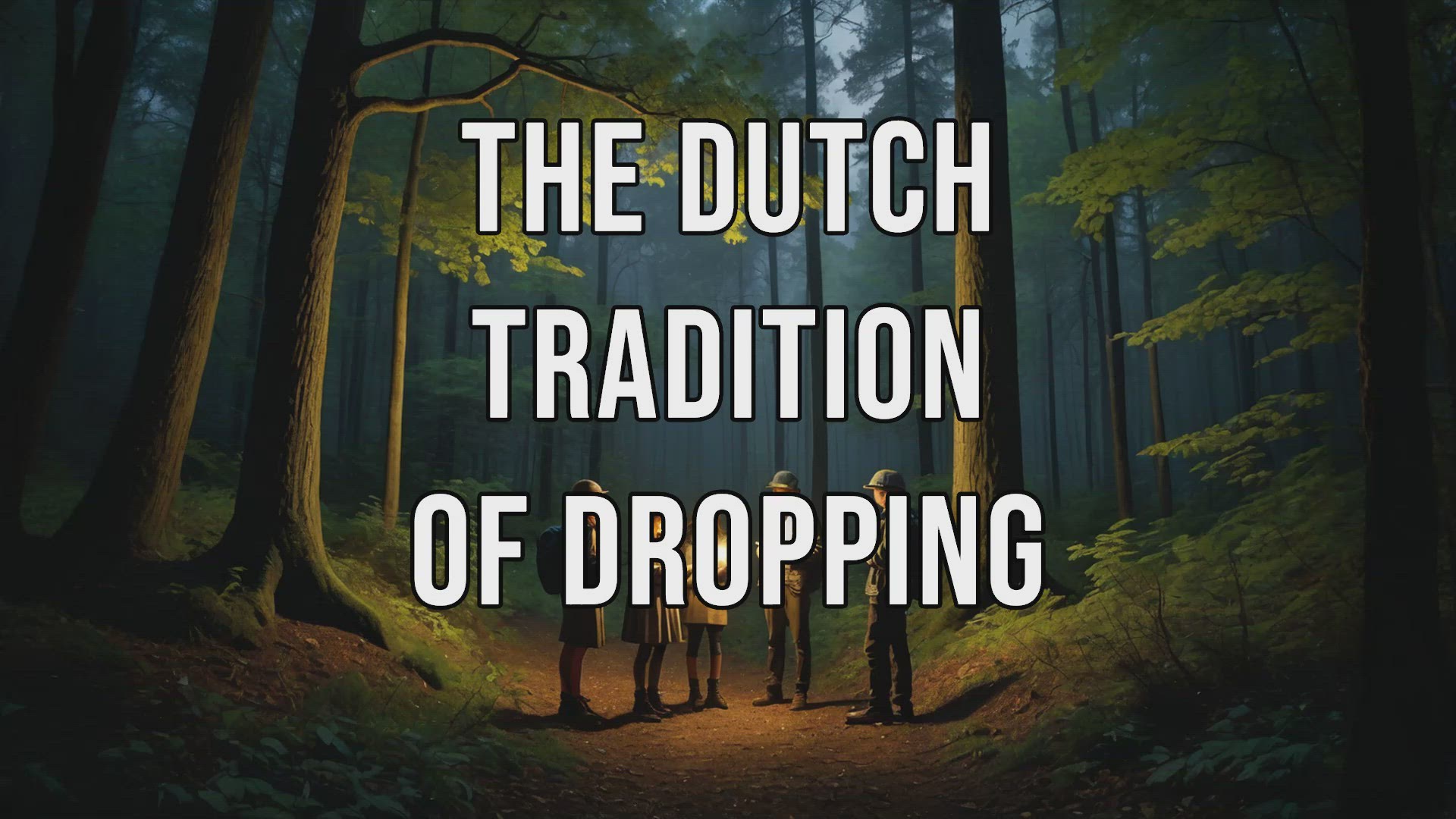
The Dutch Tradition of Dropping
718 views · Sep 15, 2024 humix_publisher_525837
The Dutch tradition of "Dropping" involves leaving children aged 8 to 15 in remote areas at night to foster independence, teamwork, and resilience. Equipped with maps and flashlights, they navigate back to a meeting point under adult supervision. Critics voice concerns about its demands, but proponents highlight its safety and educational value. As urbanization rises, Droppings remind us of the importance of self-reliance and outdoor skills in childhood development. #Dropping #DutchTradition #ChildDevelopment #Teamwork #OutdoorAdventure

The First Guest A Vietnamese New Year Tradition
95 views · Sep 15, 2024 humix_publisher_525837
In Vietnam, the first guest to enter a home during the New Year is believed to influence the household's luck for the entire year. Families carefully select this individual based on their character and fortune, reflecting the cultural significance of omens and traditions. This practice highlights the interconnectedness and values of the Vietnamese community, offering insight into their rich customs and beliefs. #VietnamTradition #NewYearCustoms #CulturalHeritage #GoodFortune #Superstitions Vietnam is a country rich in traditions, and one such custom that may surprise many foreigners is the practice concerning the first guest of the New Year. In Vietnam, the identity of the first person to enter a home once the New Year has commenced holds significant importance. This age-old belief posits that this individual has the power to influence the household’s luck for the entire year, either bringing prosperity or misfortune. Understanding the gravity of this tradition, Vietnamese families often plan meticulously to ensure that the first guest who crosses their threshold is someone of reputable character and good fortune. This meticulous selection underscores the cultural emphasis placed on omens and the future ramifications they might bear. Consequently, this practice is much more than a mere superstition; it is an ingrained cultural routine that mirrors the Vietnamese community’s interconnectedness, values, and respect for long-standing beliefs. Observing this tradition offers a fascinating lens through which to understand the complexities of Vietnamese customs and the broader cultural context in which they thrive.

Navigating Russian Hospitality Etiquette
2K views · Sep 15, 2024 humix_publisher_525837
Understanding Russian hospitality customs is essential for a positive experience when visiting a Russian home. Guests should bring a thoughtful gift, preferably in odd numbers, and avoid shaking hands or kissing at the threshold. Removing shoes upon entry is customary, and showing appreciation for the host's efforts is important. Engaging in conversation and expressing gratitude upon leaving enhances the cultural exchange. #RussianHospitality #CulturalEtiquette #TravelTips #GuestEtiquette #RespectTraditions

The Evolution of Handshaking
119 views · Sep 16, 2024 humix_publisher_525837
The Evolution of Handshaking Handshaking dates back to Ancient Greece, symbolizing trust and equality since the 5th century BC. Initially a gesture of mutual respect, it evolved from a means to show peaceful intentions in a time of swords. While common in Western culture, greetings vary globally, with alternatives like bowing in Japan and elbow bumps during the COVID-19 pandemic. The handshake remains a significant social gesture, reflecting trust and cooperation. After researching all sorts of archaeological ruins, Western scientists have declared that the practice of handshaking was used as far back as Ancient Greece and, more specifically, as early as the 5th century BC. Historians have found images on ancient pots that show, for example, how people touch hands when making deals. For thousands of years, the handshake has symbolized trust and equality. In ancient times, the gesture was used between people of equal status, showing mutual respect and willingness to cooperate. The traditional handshake as we know it in the 21st century is thought to have come from a time when people often used swords in battle. People carried them in a sheath on their left side, meaning they could pull the weapon out with their right hand if necessary. Thus, the traditional shaking of the right hand became a friendly greeting - as it proved that two people came in peace and did not plan to take up arms. The handshake was also a sign of trust: a person believed that his interlocutor would not draw his sword for battle. Western manners expert William Hanson explains, 'A handshake shows that you have not harmed anyone. This is important today because it is a sign of social trust.' Thus, it is not only in politics that one can observe status people shaking hands as a sign of respect: players do not often shake hands before sporting matches, and the same business people shake hands before and after meetings. However, sometimes, people avoid shaking hands out of disrespect and prefer a different greeting. For example, at the third and last US televised debate in October 2016, presidential candidates Donald Trump and Hillary Clinton did not shake hands. Although the handshake is probably the most common greeting, it's not the traditional way in every country. William Hanson explains, 'In Japan, for example, they bow, and in other Asian countries - Thailand, for example - they do namaste.' Namaste is when the person greeting usually says 'Namaste' to the other by putting their hands together and slightly bowing. In some Middle Eastern countries, shaking hands is done, but not as firmly as is customary in the West. In China, the handshake is usually lighter and can last up to 10 seconds. In other countries, such as France, you may also be kissed on the cheek to say hello or goodbye. Another way is the 'Elbow Bump' ('elbow touch'). In recent years, especially during the COVID-19 pandemic, elbow touching has become a popular alternative to shaking hands. This gesture maintains social distance and minimizes the risk of transmitting infections while remaining friendly. #handshake #trust #greetings #culturalexchange #history

The Evolution of Handshaking
119 views · Sep 16, 2024 humix_publisher_525837
The Evolution of Handshaking Handshaking dates back to Ancient Greece, symbolizing trust and equality since the 5th century BC. Initially a gesture of mutual respect, it evolved from a means to show peaceful intentions in a time of swords. While common in Western culture, greetings vary globally, with alternatives like bowing in Japan and elbow bumps during the COVID-19 pandemic. The handshake remains a significant social gesture, reflecting trust and cooperation. After researching all sorts of archaeological ruins, Western scientists have declared that the practice of handshaking was used as far back as Ancient Greece and, more specifically, as early as the 5th century BC. Historians have found images on ancient pots that show, for example, how people touch hands when making deals. For thousands of years, the handshake has symbolized trust and equality. In ancient times, the gesture was used between people of equal status, showing mutual respect and willingness to cooperate. The traditional handshake as we know it in the 21st century is thought to have come from a time when people often used swords in battle. People carried them in a sheath on their left side, meaning they could pull the weapon out with their right hand if necessary. Thus, the traditional shaking of the right hand became a friendly greeting - as it proved that two people came in peace and did not plan to take up arms. The handshake was also a sign of trust: a person believed that his interlocutor would not draw his sword for battle. Western manners expert William Hanson explains, 'A handshake shows that you have not harmed anyone. This is important today because it is a sign of social trust.' Thus, it is not only in politics that one can observe status people shaking hands as a sign of respect: players do not often shake hands before sporting matches, and the same business people shake hands before and after meetings. However, sometimes, people avoid shaking hands out of disrespect and prefer a different greeting. For example, at the third and last US televised debate in October 2016, presidential candidates Donald Trump and Hillary Clinton did not shake hands. Although the handshake is probably the most common greeting, it's not the traditional way in every country. William Hanson explains, 'In Japan, for example, they bow, and in other Asian countries - Thailand, for example - they do namaste.' Namaste is when the person greeting usually says 'Namaste' to the other by putting their hands together and slightly bowing. In some Middle Eastern countries, shaking hands is done, but not as firmly as is customary in the West. In China, the handshake is usually lighter and can last up to 10 seconds. In other countries, such as France, you may also be kissed on the cheek to say hello or goodbye. Another way is the 'Elbow Bump' ('elbow touch'). In recent years, especially during the COVID-19 pandemic, elbow touching has become a popular alternative to shaking hands. This gesture maintains social distance and minimizes the risk of transmitting infections while remaining friendly. #handshake #trust #greetings #culturalexchange #history
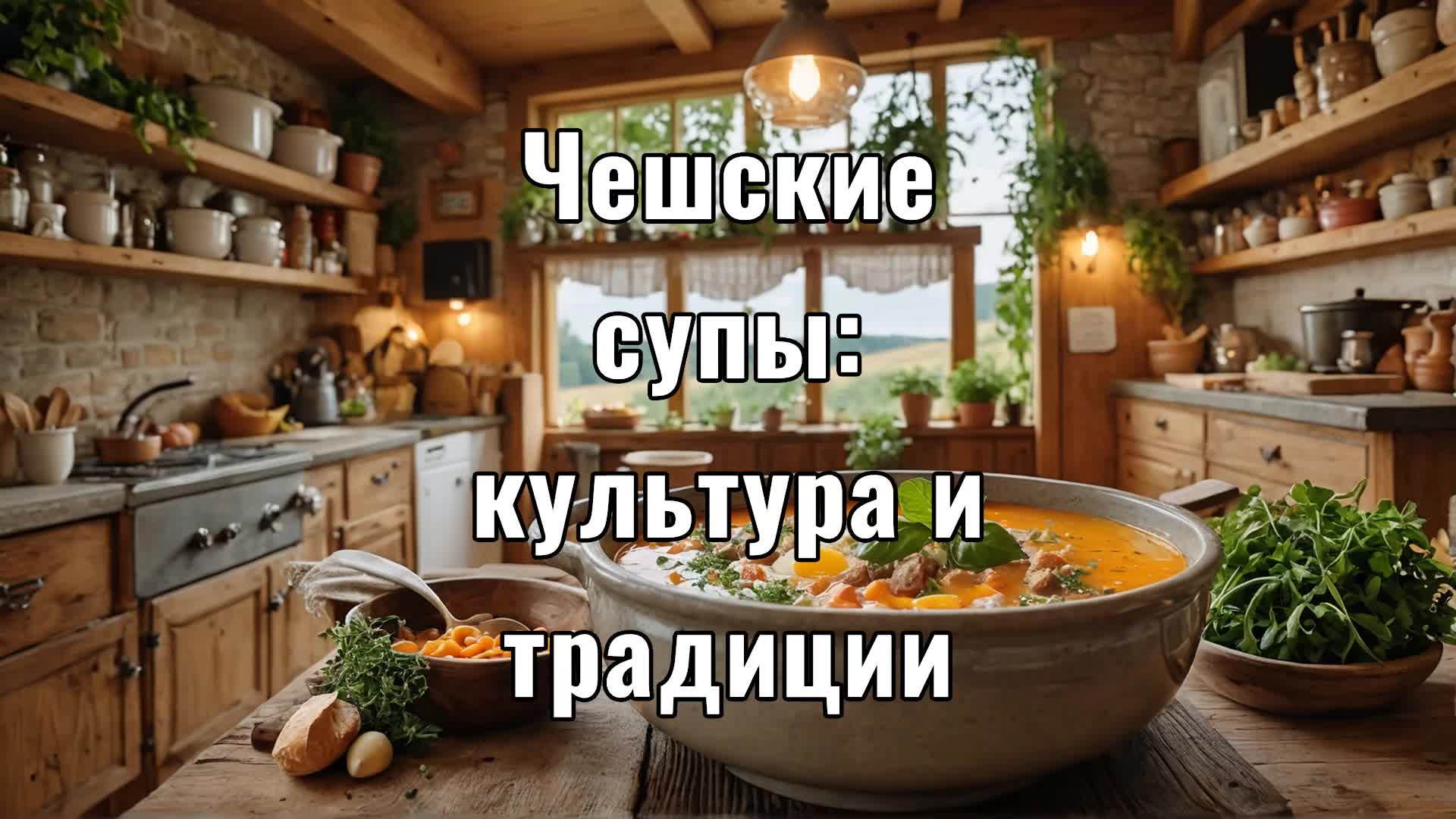
Чешские супы культура и традиции
569 views · Dec 29, 2024 humix_publisher_525837
В Чехии супы представляют собой не просто еду, а целую культуру с глубокими традициями. Каждый суп, от брамборачки до кисело, рассказывает свою уникальную историю, наполняя кухню ароматами уюта и тепла. Эти блюда, такие как чеснечка и фазолова, не только согревают тело, но и создают незабываемые моменты, отражая любовь чехов к жизни и их кулинарное наследие. #чешскаякухня #супы #традиции #вкусно #уют В Чехии супы — это не просто еда, это целая культура, уходящая корнями в глубокую историю и традиции. Каждый из этих супов словно рассказывает свою уникальную историю, наполняя кухню ароматами, которые обещают уют и тепло даже в самый холодный день. Брамборачка — это крем-суп из картофеля, он создаёт ощущение домашнего уюта. Его густая, насыщенная текстура и мягкий вкус картофеля, дополненный ароматными специями, делают его идеальным блюдом для зимних вечеров. Чеснечка, или чесночный суп, — это взрыв вкусовых рецепторов. Его ароматный, чесночный бульон, усиленный яйцом и сыром, возбуждает аппетит и согревает, словно теплое объятие. Каждый глоток этого супа напоминает о друзьях, собравшихся за столом. Кулайда — это легенда весны, суп, в котором кресс-салат и грибы создают свежий и в то же время насыщенный вкус. Он как первый луч солнца после долгой зимы, приносящий с собой обещание обновления и новых начал. Рыбья полевка — это дань уважения чешским рекам и озерам. Суп из карпа или другого речного жителя, с добавлением вина и пряностей, напоминает о праздниках, когда вся семья собирается за большим столом. Фазолова — суп из фасоли, который захватывает своей простой, но глубокой насыщенностью. Каждый боб, пропитанный ароматами копчёного мяса или колбасы, рассказывает о сельской жизни, о том времени, когда еда была не только питанием, но и событием. Зелнячка — капустный суп, который словно приглашает вас в прошлое, где каждая хозяйка знала секрет приготовления идеального бульона. Его кисло-сладкий вкус согревает и напоминает о важности сохранения традиций. Чочкова полевка — свиной суп, где каждая ложка полна воспоминаниями о праздничных застольях, где мясо и овощи варятся вместе, создавая гармонию вкусов, что делает этот суп не просто едой, а событием. Цибулачка — луковый суп, который может показаться простым, но его глубокий, сладковатый вкус лука, запеченного в бульоне, создаёт настоящий вкусовой праздник. Это суп, который умеет утешать и согревать. Кисело — кислые щи, где кислая капуста играет главную роль, добавляя блюду особенный, немного пикантный вкус, который так любят в Чехии. Это суп для тех, кто ценит контрасты и любит поиграть с вкусами. Зеленинова полевка — овощной суп, который словно говорит о богатстве чешской земли. Смесь разнообразных овощей, каждый со своим уникальным вкусом, создаёт палитру, которая радует и глаз, и желудок. Каждый из этих супов — это часть чешской души, рассказывающая о культуре, истории и любви к жизни. Они согревают не только тело, но и душу, создавая моменты, которые запоминаются на всю жизнь.

Les soupes tchèques un réconfort culturel
1K views · Dec 29, 2024 humix_publisher_525837
Les soupes tchèques : un réconfort culturel En République tchèque, les soupes sont bien plus qu'un simple plat ; elles incarnent une culture riche et des traditions profondes. Chaque soupe, comme la bramboračka ou la česnečka, raconte une histoire unique, évoquant chaleur et confort. De la légèreté de la kuáide à la profondeur de la fazolová, ces recettes sont des reflets de l'âme tchèque, réchauffant le corps et l'esprit à travers des moments partagés. #soupe #culture #tradition #gastronomie #RépubliqueTchèque En République tchèque, les soupes ne sont pas simplement de la nourriture, elles constituent toute une culture, enracinée dans une histoire et des traditions profondes. Chacune de ces soupes semble raconter sa propre histoire unique, remplissant la cuisine d'arômes qui promettent confort et chaleur même lors des jours les plus froids. La bramboračka est une soupe crémeuse à base de pommes de terre, elle crée une sensation de confort domestique. Sa texture épaisse et riche et le goût doux de la pomme de terre, rehaussé d'épices aromatiques, en font un plat idéal pour les soirées d'hiver. Imaginez une cuillère plongée dans cette masse délicate, laissant sur la langue une saveur inoubliable. La česnečka, ou soupe à l'ail, est une explosion de saveurs. Son bouillon aromatique à l'ail, renforcé par un œuf et du fromage, stimule l'appétit et réchauffe, tel un câlin chaleureux. Chaque gorgée de cette soupe rappelle les amis réunis autour de la table, partageant chaleur et histoires communes. La kuáide est la légende du printemps, une soupe où le cresson et les champignons créent une saveur fraîche et en même temps riche. Elle est comme le premier rayon de soleil après un long hiver, apportant avec elle la promesse de renouveau et de nouveaux commencements. La rybí polévka est un hommage aux rivières et lacs tchèques. Une soupe de carpe ou d'un autre habitant des rivières, avec du vin et des épices, rappelle les fêtes où toute la famille se rassemble autour d'une grande table, attendant le miracle de Noël. La fazolová est une soupe de haricots qui captive par sa simplicité mais aussi sa profondeur. Chaque grain, imprégné des arômes de viande fumée ou de saucisse, raconte la vie rurale, à une époque où la nourriture était non seulement un besoin, mais aussi un événement. La zelňačka est une soupe de chou qui semble vous inviter dans le passé, où chaque maîtresse de maison connaissait le secret de la préparation du bouillon parfait. Son goût aigre-doux réchauffe et rappelle l'importance de préserver les traditions. La čočková polévka est une soupe de porc, où chaque cuillerée est pleine de souvenirs de festins, où la viande et les légumes mijotent ensemble, créant une harmonie de saveurs, ce qui fait de cette soupe non seulement un plat, mais un événement. La cibulačka est une soupe à l'oignon qui peut sembler simple, mais son goût profond et sucré d'oignon rôti dans le bouillon crée une véritable fête des saveurs. C'est une soupe qui sait réconforter et réchauffer. Le kyselo est une soupe aigre, où le chou aigre joue le rôle principal, ajoutant au plat une saveur particulière, légèrement piquante, très appréciée en République tchèque. C'est une soupe pour ceux qui apprécient les contrastes et aiment jouer avec les saveurs. La zeleninová polévka est une soupe de légumes qui parle de la richesse de la terre tchèque. Un mélange de légumes variés, chacun avec son goût unique, crée une palette qui ravit à la fois les yeux et l'estomac. Chacune de ces soupes est une partie de l'âme tchèque, racontant la culture, l'histoire et l'amour de la vie. Elles réchauffent non seulement le corps, mais aussi l'âme, créant des moments qui restent gravés à jamais.
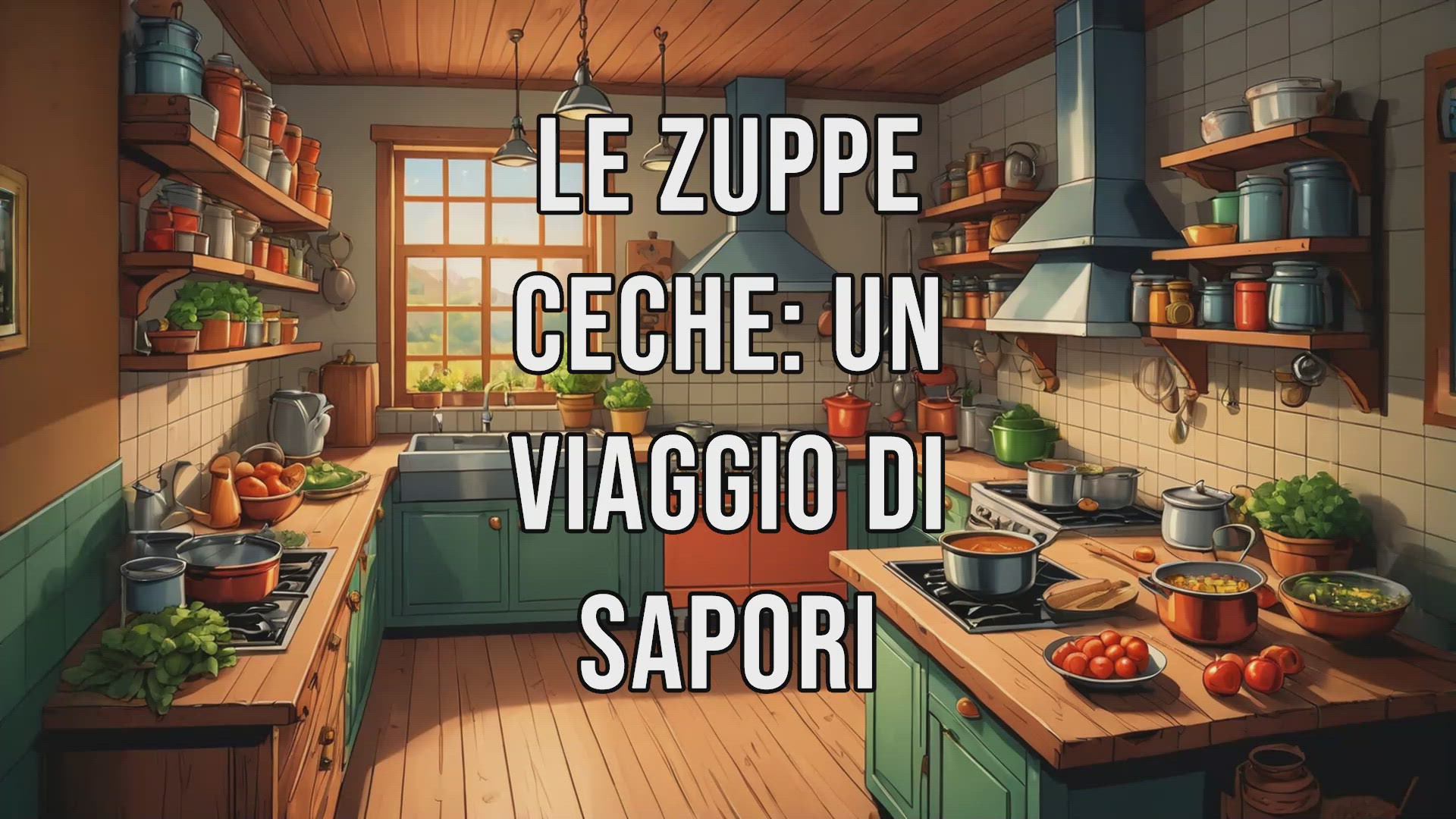
Le zuppe ceche un viaggio di sapori
6K views · Dec 29, 2024 humix_publisher_525837
Le zuppe ceche: un viaggio di sapori In Repubblica Ceca, le zuppe rappresentano una cultura profonda e tradizionale. Ogni zuppa, dalla bramboračka alla zelňačka, racconta storie uniche e riscalda il cuore. Questi piatti, ricchi di aromi e sapori, evocano momenti di convivialità e ricordi familiari. Attraverso ingredienti freschi e ricette storiche, le zuppe ceche non sono solo cibo, ma un'esperienza che nutre l'anima. #cucina #tradizione #comfortfood #cultura #zuppe In Repubblica Ceca, le zuppe non sono solo cibo, ma una vera e propria cultura, che affonda le radici in una storia e tradizioni profonde. Ognuna di queste zuppe sembra raccontare la propria storia unica, riempiendo la cucina di aromi che promettono calore e accoglienza anche nei giorni più freddi. La bramboračka è una crema di patate che crea un senso di calore domestico. La sua consistenza densa e ricca e il morbido sapore delle patate, arricchito da spezie aromatiche, la rendono un piatto ideale per le serate invernali. Immaginate un cucchiaio che affonda in questa massa delicata, lasciando in bocca un retrogusto inconfondibile. La česnečka, o zuppa d'aglio, è un'esplosione di sapori. Il suo brodo aromatico all'aglio, rinforzato da uova e formaggio, stimola l'appetito e riscalda, come un abbraccio caldo. Ogni sorso di questa zuppa ricorda gli amici riuniti attorno a un tavolo, condividendo calore e storie comuni. La kuřida è la leggenda della primavera, una zuppa in cui il crescione e i funghi creano un sapore fresco e al tempo stesso ricco. È come il primo raggio di sole dopo un lungo inverno, portando con sé la promessa di rinnovamento e nuovi inizi. La rybí polévka è un omaggio ai fiumi e laghi cechi. Una zuppa di carpa o di un altro abitante d'acqua dolce, con l'aggiunta di vino e spezie, ricorda le festività, quando tutta la famiglia si riunisce attorno a un grande tavolo, aspettando il miracolo del Natale. La fazolová è una zuppa di fagioli che cattura con la sua semplicità, ma profonda ricchezza. Ogni fagiolo, impregnato degli aromi di carne affumicata o salsiccia, racconta della vita rurale, di un tempo in cui il cibo era non solo nutrimento, ma anche un evento. La zelňačka è una zuppa di cavolo che sembra invitarti nel passato, dove ogni padrona di casa conosceva il segreto per preparare il brodo perfetto. Il suo sapore agrodolce riscalda e ricorda l'importanza di preservare le tradizioni. La čočková polévka è una zuppa di maiale, dove ogni cucchiaio è pieno di ricordi di banchetti festivi, dove carne e verdure vengono cotte insieme, creando un'armonia di sapori che rende questa zuppa non solo un pasto, ma un evento. La cibulačka è una zuppa di cipolle che può sembrare semplice, ma il suo profondo e dolce sapore di cipolla, arrostita nel brodo, crea una vera festa di sapori. È una zuppa che sa consolare e riscaldare. La kyselo è una zuppa acida, dove il cavolo acido gioca il ruolo principale, aggiungendo al piatto un sapore particolare, leggermente piccante, molto amato in Repubblica Ceca. Questa è una zuppa per chi apprezza i contrasti e ama giocare con i sapori. La zeleninová polévka è una zuppa di verdure che parla della ricchezza della terra ceca. Una miscela di diverse verdure, ognuna con il proprio sapore unico, crea una palette che delizia sia gli occhi che lo stomaco. Ognuna di queste zuppe è parte dell'anima ceca, raccontando di cultura, storia e amore per la vita. Riscaldano non solo il corpo, ma anche l'anima, creando momenti che rimangono impressi per tutta la vita.
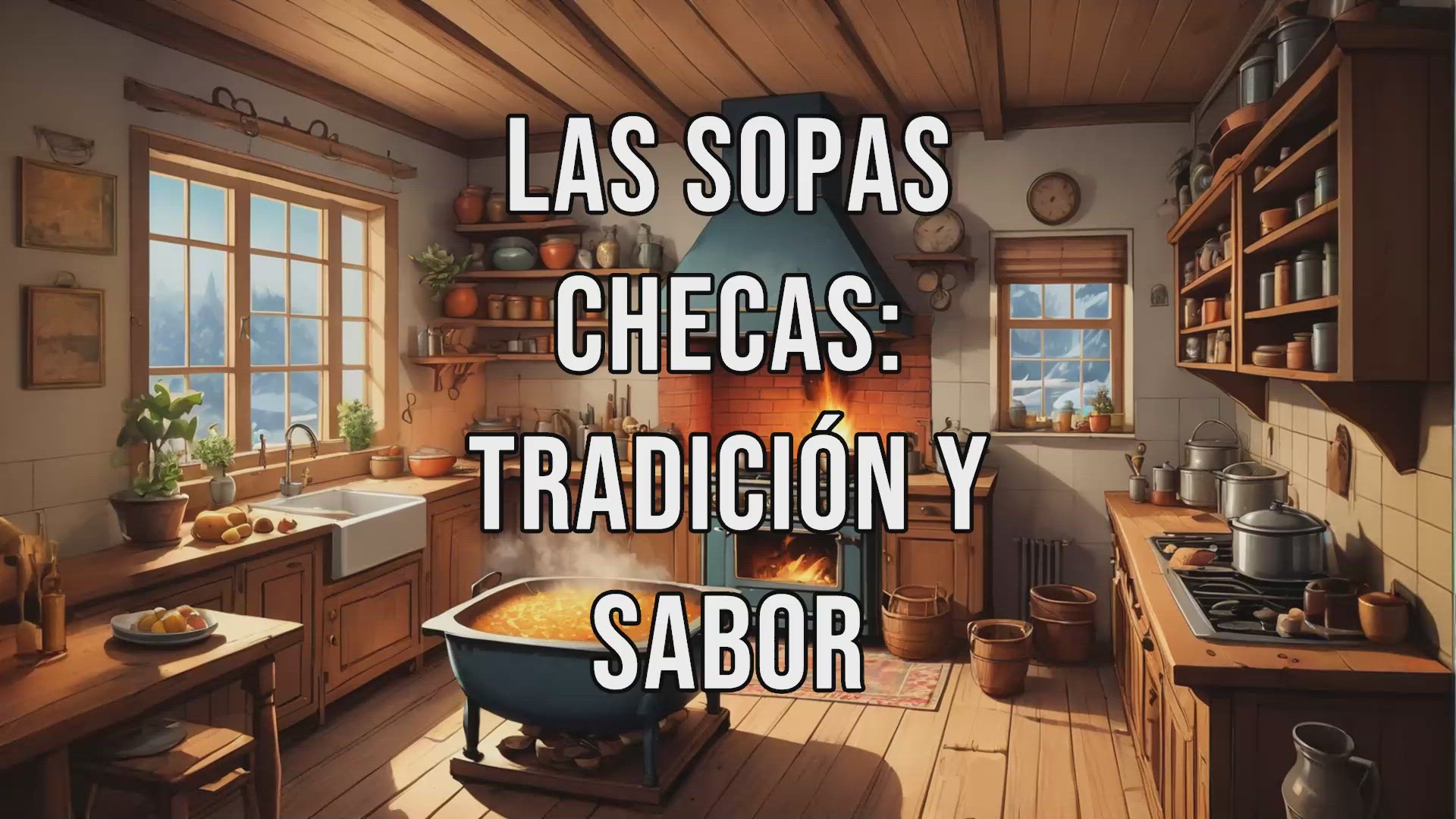
Las sopas checas tradición y sabor
57 views · Dec 29, 2024 humix_publisher_525837
Las sopas checas: tradición y sabor En Chequia, las sopas son más que un plato; son un reflejo de la cultura y la historia del país. Desde la reconfortante Bramboračka hasta la festiva Rybí polévka, cada sopa cuenta una historia única. Con ingredientes frescos y sabores profundos, estas sopas evocan recuerdos y celebraciones familiares, calentando el cuerpo y el alma. Son un homenaje a la tradición culinaria checa, donde cada cucharada es un viaje a través del tiempo. #sopas #cultura #tradiciones #Chequia #sabores En Chequia, las sopas no son solo comida, son toda una cultura que se remonta a una profunda historia y tradiciones. Cada una de estas sopas parece contar su propia historia única, llenando la cocina con aromas que prometen calidez y confort incluso en el día más frío. Bramboračka es una crema de sopa de patata que crea una sensación de hogar. Su textura espesa y rica y el suave sabor de la patata, complementado con especias aromáticas, la convierten en el plato ideal para las noches de invierno. Česnečka, o sopa de ajo, es una explosión de sabores. Su aromático caldo de ajo, realzado con huevo y queso, despierta el apetito y calienta, como un abrazo cálido. Cada sorbo de esta sopa recuerda a amigos reunidos alrededor de la mesa. Květa es la leyenda de la primavera, una sopa en la que el berro y los champiñones crean un sabor fresco y a la vez rico. Es como el primer rayo de sol después de un largo invierno, trayendo consigo la promesa de renovación y nuevos comienzos. Rybí polévka es un homenaje a los ríos y lagos checos. Una sopa de carpa u otro habitante del río, con vino y especias, recuerda las festividades cuando toda la familia se reúne alrededor de una gran mesa, esperando el milagro de la Navidad. Fazolová es una sopa de frijoles que cautiva con su simple pero profunda riqueza. Cada frijol, impregnado de los aromas de carne ahumada o salchichas, cuenta sobre la vida rural, sobre el tiempo en que la comida no era solo nutrición, sino un evento. Zelňačka es una sopa de col que parece invitarte al pasado, donde cada ama de casa conocía el secreto para preparar el caldo perfecto. Su sabor agridulce calienta y recuerda la importancia de preservar las tradiciones. Čočková polévka es una sopa de cerdo, donde cada cucharada está llena de recuerdos de banquetes festivos, donde la carne y las verduras se cocinan juntas, creando una armonía de sabores que convierte esta sopa en un evento, no solo en comida. Cibulačka es una sopa de cebolla que puede parecer simple, pero su profundo y dulce sabor de cebolla asada en caldo crea una verdadera fiesta de sabores. Es una sopa que sabe consolar y calentar. Kyselo son sopas ácidas, donde la col agria juega el papel principal, añadiendo al plato un sabor especial, un poco picante, que es muy apreciado en Chequia. Esta sopa es para aquellos que valoran los contrastes y les gusta jugar con los sabores. Zeleninová polévka es una sopa de verduras que habla sobre la riqueza de la tierra checa. Una mezcla de diversas verduras, cada una con su sabor único, crea una paleta que alegra tanto la vista como el estómago. Cada una de estas sopas es parte del alma checa, contando sobre la cultura, la historia y el amor por la vida. Calientan no solo el cuerpo, sino también el alma, creando momentos que se recuerdan toda la vida.
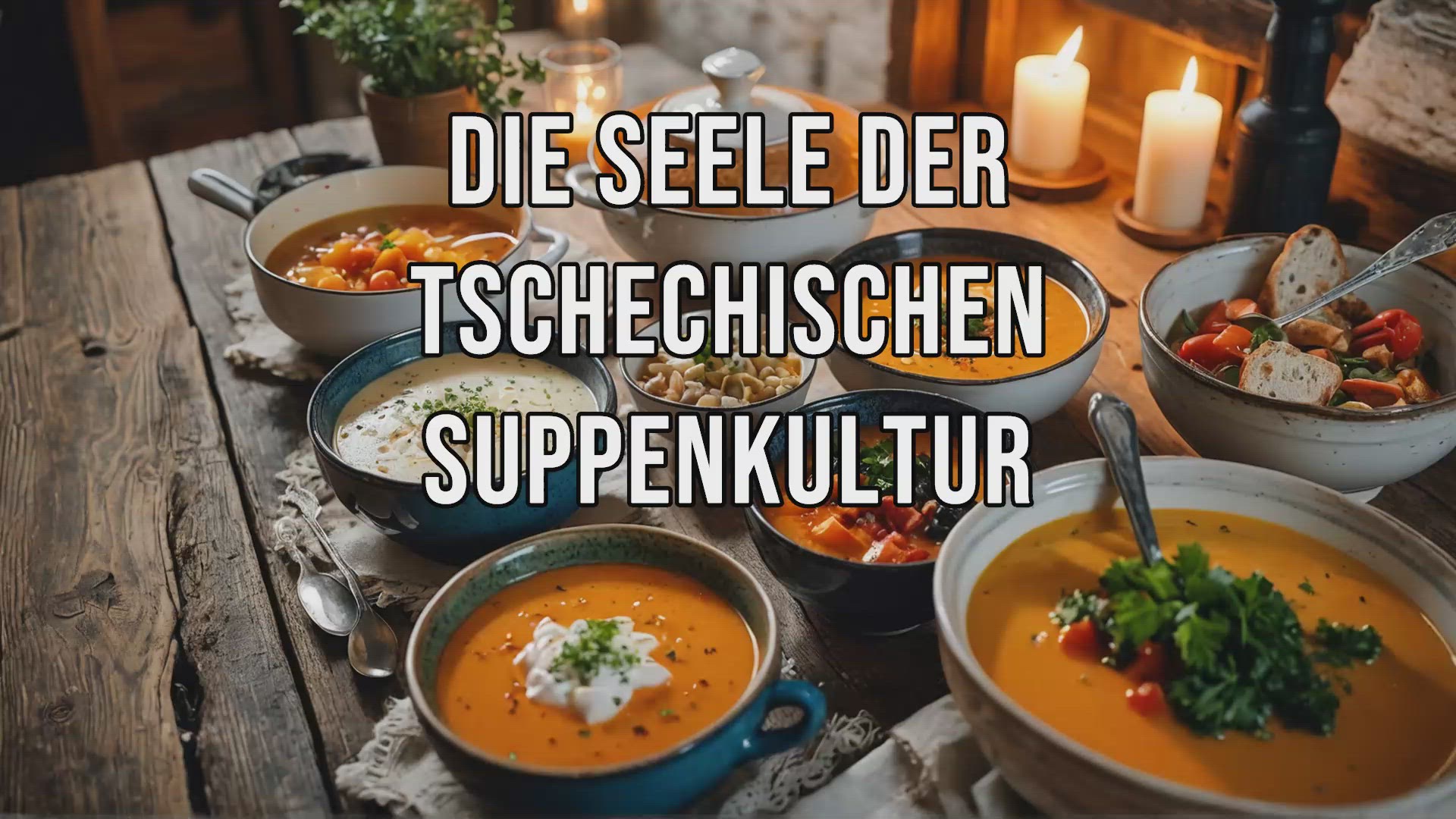
Die Seele der tschechischen Suppenkultur
601 views · Dec 29, 2024 humix_publisher_525837
Die Seele der tschechischen Suppenkultur In Tschechien sind Suppen mehr als nur Nahrung; sie sind ein kulturelles Erbe, das Geschichten erzählt und Wärme spendet. Von der cremigen Bramboracka bis zur aromatischen Czesneczka, jede Suppe verkörpert Tradition und Gemeinschaft. Kualida symbolisiert den Frühling, während Fischpolivka an festliche Zusammenkünfte erinnert. Diese Suppen sind nicht nur Gerichte, sondern auch Erinnerungen, die die tschechische Seele prägen. #tschechischeküche #suppenkultur #gemütlichkeit #tradition #wärme In Tschechien sind Suppen nicht nur Nahrung, sie sind eine ganze Kultur, die tief in der Geschichte und Tradition verwurzelt ist. Jede dieser Suppen erzählt ihre eigene einzigartige Geschichte und erfüllt die Küche mit Aromen, die selbst an den kältesten Tagen Gemütlichkeit und Wärme versprechen. Bramboracka ist eine cremige Kartoffelsuppe, die ein Gefühl von heimeliger Behaglichkeit vermittelt. Ihre dicke, reichhaltige Textur und der sanfte Geschmack der Kartoffeln, ergänzt durch aromatische Gewürze, machen sie zu einem idealen Gericht für winterliche Abende. Czesneczka, oder Knoblauchsuppe, ist eine Explosion der Geschmacksknospen. Ihr aromatischer, knoblauchhaltiger Brühe, verstärkt durch Ei und Käse, regt den Appetit an und wärmt wie eine warme Umarmung. Jeder Schluck dieser Suppe erinnert an Freunde, die sich um den Tisch versammeln. Kualida ist die Legende des Frühlings, eine Suppe, in der Kresse und Pilze einen frischen und gleichzeitig reichhaltigen Geschmack kreieren. Sie ist wie der erste Sonnenstrahl nach einem langen Winter, der das Versprechen von Erneuerung und neuen Anfängen mit sich bringt. Fischpolivka ist eine Hommage an die tschechischen Flüsse und Seen. Eine Suppe aus Karpfen oder einem anderen Flussbewohner, verfeinert mit Wein und Gewürzen, erinnert an Feste, bei denen die ganze Familie um einen großen Tisch versammelt ist und auf das Wunder von Weihnachten wartet. Fazolova ist eine Bohnensuppe, die mit ihrer einfachen, aber tiefen Intensität fesselt. Jede Bohne, durchzogen von den Aromen von geräuchertem Fleisch oder Wurst, erzählt von ländlichem Leben, von der Zeit, als Essen nicht nur Nahrung, sondern auch ein Ereignis war. Zelňáčka ist eine Kohlsuppe, die Sie in die Vergangenheit einlädt, wo jede Hausfrau das Geheimnis der perfekten Brühe kannte. Ihr süß-saurer Geschmack wärmt und erinnert an die Bedeutung der Bewahrung von Traditionen. Čočková polévka ist eine Schweinsuppe, in der jeder Löffel voller Erinnerungen an festliche Tafeln ist, wo Fleisch und Gemüse zusammen gekocht werden und eine Harmonie der Geschmäcker schaffen, die diese Suppe zu mehr als nur Nahrung macht – sie ist ein Ereignis. Cibulačka ist eine Zwiebelsuppe, die einfach erscheinen mag, aber ihr tiefer, süßlicher Geschmack von im Brühe gerösteten Zwiebeln schafft ein wahres Fest der Aromen. Es ist eine Suppe, die trösten und wärmen kann. Kyselo sind saure Suppen, in denen die saure Kohl die Hauptrolle spielt und dem Gericht einen besonderen, leicht pikanten Geschmack verleiht, der in Tschechien so geschätzt wird. Diese Suppe ist für diejenigen, die Kontraste schätzen und gerne mit Geschmäckern spielen. Zeleninová polévka ist eine Gemüsesuppe, die von dem Reichtum des tschechischen Landes erzählt. Eine Mischung aus verschiedenen Gemüsesorten, jede mit ihrem einzigartigen Geschmack, schafft eine Palette, die sowohl das Auge als auch den Magen erfreut. Jede dieser Suppen ist ein Teil der tschechischen Seele, die von Kultur, Geschichte und Lebensliebe erzählt. Sie wärmen nicht nur den Körper, sondern auch die Seele und schaffen Momente, die ein Leben lang in Erinnerung bleiben.
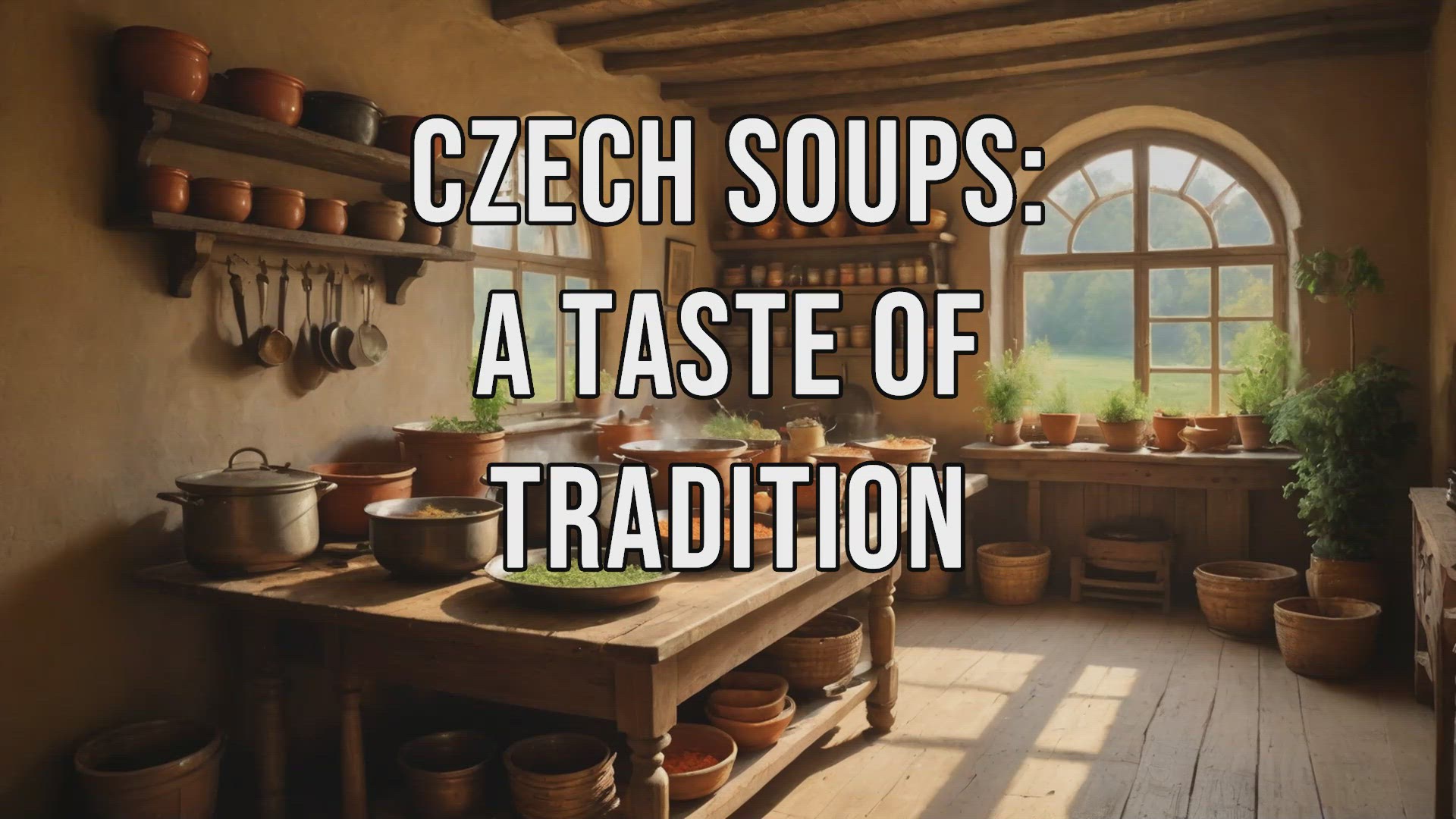
Czech Soups A Taste of Tradition
930 views · Dec 29, 2024 humix_publisher_525837
Czech Soups: A Taste of Tradition In the Czech Republic, soups are more than just food; they embody a rich culture and history. From the comforting Bramboračka to the flavorful Česnečka, each soup tells a unique story. Seasonal delights like Květa celebrate renewal, while Rybí polévka evokes family gatherings. Simple yet profound, soups like Fazolová and Zelňačka reflect rural life and traditions. Each bowl offers warmth, comfort, and a connection to the Czech soul. #CzechCuisine #SoupCulture #ComfortFood #FoodTraditions #CulinaryHeritage [Script] In the Czech Republic, soups are not just food; they are a whole culture rooted in deep history and traditions. Each of these soups seems to tell its unique story, filling the kitchen with aromas that promise comfort and warmth even on the coldest day. Bramboračka is a creamy potato soup that creates a sense of homey coziness. Its thick, rich texture and soft potato flavor, complemented by aromatic spices, make it the perfect dish for winter evenings. Imagine a spoon diving into this tender mass, leaving an unforgettable aftertaste on your tongue. Česnečka, or garlic soup, is an explosion of flavors. Its aromatic garlic broth, enhanced with egg and cheese, stimulates the appetite and warms you like a warm embrace. Each sip of this soup reminds you of friends gathered around the table, sharing warmth and common stories. Květa is the legend of spring, a soup where watercress and mushrooms create a fresh yet rich flavor. It’s like the first ray of sunshine after a long winter, bringing with it the promise of renewal and new beginnings. Rybí polévka is a tribute to Czech rivers and lakes. A soup made from carp or another river dweller, with the addition of wine and spices, evokes memories of holidays when the whole family gathers around a large table, awaiting the miracle of Christmas. Fazolová is a bean soup that captivates with its simple yet deep richness. Each bean, soaked in the aromas of smoked meat or sausage, tells tales of rural life, of a time when food was not just sustenance but an event. Zelňačka is a cabbage soup that seems to invite you into the past, where every housewife knew the secret to making the perfect broth. Its sweet-sour taste warms you and reminds you of the importance of preserving traditions. Čočková polévka is a pork soup where each spoonful is full of memories of festive feasts, where meat and vegetables boil together, creating a harmony of flavors that makes this soup not just a meal but an event. Cibulačka is an onion soup that may seem simple, but its deep, sweet flavor of onions baked in broth creates a true feast for the taste buds. This is a soup that knows how to comfort and warm. Kyselo is sour cabbage soup, where sour cabbage plays the leading role, adding a special, slightly tangy flavor that is so loved in the Czech Republic. This soup is for those who appreciate contrasts and love to play with flavors. Zeleninová polévka is a vegetable soup that speaks of the richness of Czech land. A mix of various vegetables, each with its unique flavor, creates a palette that delights both the eye and the stomach. Each of these soups is a part of the Czech soul, telling stories of culture, history, and love for life. They warm not only the body but also the soul, creating moments that are remembered for a lifetime.

A Taste of Southern Italy: Ragù alla Pugliese
3K views · Jan 30, 2025 humix_publisher_525837
In Apulia—just like in other parts of Italy—stews and sauces are most often made with various portions of meat: pork and veal, chicken, rabbit, lamb, or even a selection of game meat. Traditionally, ragù alla Pugliese is made with chicken, beef, pancetta, and pork sausage. Still, after hours of slow simmering, your ragù will taste just as good, possibly even better, made with pork, veal, or lamb alone. In fact, when made with lamb alone, it is called ragù del Pastore (lit. shepherd's sauce). This variant uses more red pepper, which imparts a nice piquant heat to the dish. Both sauces are served over pasta, most typically orecchiette, and they are often enjoyed with a good sprinkle of castrato Pugliese or pecorino cheese. Ragù alla Pugliese is a hearty meat sauce from the Puglia region in southern Italy. Here's a basic recipe for you to try: Ingredients: 500g pork shoulder, diced 300g beef chuck, diced 1 large onion, finely chopped 2 carrots, finely chopped 2 celery stalks, finely chopped 2 cloves of garlic, minced 1 cup of red wine (preferably a local Puglian wine like Primitivo) 2 cups of tomato passata or canned tomatoes, crushed A handful of fresh basil, torn 1 sprig of rosemary Salt and pepper to taste Olive oil for cooking Instructions: Preparation: Mix olive oil in a large, heavy-bottomed pot over medium heat. Add the onions, carrots, and celery, cooking until they are soft and translucent, about 10 minutes. Add garlic towards the end to avoid burning. Brown the Meat: Increase the heat to medium-high, and add the diced pork and beef to the pot. Cook until the meat is well browned on all sides. This adds a lot of flavor to the ragù. Deglaze: Pour in the red wine, scraping the bottom of the pot to lift any stuck bits. Let the wine reduce by half; this step enriches the sauce with deep flavors. Simmer: Add the tomato passata or crushed tomatoes. Stir well to combine. Toss in the rosemary and half of the basil—season with salt and pepper. Cook Low and Slow: Reduce heat to low, cover the pot partially to allow some steam to escape, and let it simmer for at least 2-3 hours. Stir occasionally to prevent sticking. The longer it cooks, the more flavor it will develop. If the sauce becomes too thick, you can add a bit of water or stock. Finish: Remove the rosemary sprig once the meat is tender, and the sauce has thickened to your liking. Taste and adjust seasoning if necessary. Stir in the remaining basil just before serving. Serve: This sauce is traditionally served with orecchiette pasta, also from Puglia, but it goes well with any robust pasta like pappardelle or even polenta. Remember, like many traditional recipes, there's no one "right" way to make Ragù alla Pugliese. Variations might include different meats, the addition of sausage, or even some chili for a bit of heat. Enjoy your cooking! :#Puglia, #ItalianCuisine, #Ragù, #HomeCooking, #Foodie